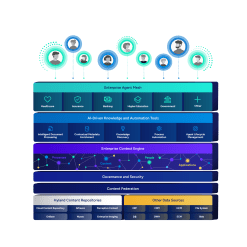Protective Insurance
Insurer migrates millions of documents.

Harness the power of a unified content, process and application intelligence platform to unlock the value of enterprise content.
Learn more
Automate your document-centric processes with AI-powered document capture, separation, classification, extraction and enrichment.
Learn about Hyland IDPIt's your unique digital evolution … but you don't have to face it alone. We understand the landscape of your industry and the unique needs of the people you serve.
 Overview of industries
Overview of industries
Countless teams and departments have transformed the way they work in accounting, HR, legal and more with Hyland solutions.
 Overview of departments
Overview of departments
We are committed to helping you maximize your technology investment so you can best serve your customers.
 Overview of services
Overview of services

Discover why Hyland is trusted by thousands of organizations worldwide.
Hear from our customers
Our exclusive partner programs combine our strengths with yours to create better experiences through content services.
Overview of partners
Find resources to power your organization's digital transformation.
Browse the resource center
Hyland connects your content and systems so you can forge stronger connections with the people who matter most.
Learn about HylandWith our modern, open and cloud-native platforms, you can build strong connections and keep evolving.
 Dig deeper
Dig deeper
Reading time minutes
Insurer migrates millions of documents.

Protective Insurance specializes in marketing and underwriting insurance for the transportation industry. Through its many property and casualty insurance companies and brokerage firms, the company accepts risks covering more than a dozen different specialty products and services and provides brokerage services for all kinds of risk.
Protective Insurance handles millions of documents in its policy, billing and claims departments. The company needed a new system for document capture and imaging and a seamless way to migrate all of its content into a single core application that was both easy to use and collaborative.
Protective Insurance’s imaging platform had been acquired and discontinued by Oracle, which did not have a migration path for the company to transfer content to a new product.
After evaluating several solutions, Protective Insurance chose Hyland's Alfresco platform as its new enterprise content management platform. The company partnered with Colorado-based Zia Consulting to help migrate all content from Oracle to the Alfresco platform.
Zia then spent the next 30 days learning the business of Protective Insurance both remotely and onsite. It also spent time talking to internal users of the platform about their content management needs.
Ryan McVeigh, VP of ECM Solutions and Sales at Zia, said, “Through our Initial Consulting Engagement (ICE), we delved into how their daily operations worked so that we could create a customized solution. Because of our ability to understand how the system needed to work, we were able to increase user adoption making the whole solution function properly and give them great results.”
Today, Protective Insurance is migrating its claims library to Alfresco platform. The migration process has also begun for the company’s other primary lines of business with Alfresco platform as the single system of record.
Thirty-one percent of companies evaluated themselves as "weak" or "very weak" in terms of business resilience and agility, while 51% self-assessed as fully resilient and agile. The results were similar across industries: financial services companies were a standout on one end, rating themselves very highly, while insurance, education and government rated themselves on the lower end.
There is a substantial misalignment between employees and executives. Forty-two percent of employees rated their company low in resilience and agility, while only 24% of executives did the same, indicating a divide between leadership and those on the ground. This misalignment is itself symptomatic of the challenges companies face in developing resilience and agility.



